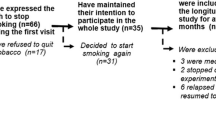Abstract
Using a double-blind procedure, 24 non-smoking subjects chewed either 2 mg nicorette® gum or a placebo for 20 min, before completing a Stroop test on three occasions. Colour-word reading and simple colour naming times were consistent across repeats, and were unaffected by nicotine. However, the time taken to name the colour of incongruous colour word stimuli declined across trials. This increase in speed across repeats was significantly greater in those subjects who had received nicotine. These data are consistent with previous reports of a decreased Stroop effect following nicotine administration, but are not compatible with a simple model which assumes that nicotine alters the way in which information is filtered by selective attentional mechanisms. The present results can be explained by postulating that nicotine influences either the rate at which colour naming become more automatic, or changes the way in which resources are allocated to non-automatic processes.
Similar content being viewed by others
References
Ashton H, Stepney K (1982) The importance of nicotine. In: Ashton H, Stepney K (eds) Smoking: psychology and pharmacology. Tavistock, London, pp 18–41
Dunbar K, MacLeod CM (1984) A horse race of a different color: Stroop interference patterns with transformed words. J Exp Psychol [Hum Percept] 10:622–639
Duncan-Johnson CC, Kopell BS (1981) The Stroop effect: brain potentials localise the source of interference. Science 214:938–940
Dunne MP, Macdonald D, Hartley LR (1986) Effects of nicotine upon memory and problem solving performance. Physiol Behav 37:849–854
Foreman N, Barraclough S, Moore C, Mehta A, Madon M (1989) High doses of caffeine impair performance of a numerical version of the Stroop task in men. Pharmacol Biochem Behav 32:399–403
Jensen AR, Rohwer WD (1966) The Stroop colour word test: a review. Acta Psychol (Amst) 25:36–93
Kahneman D, Chajczyk D (1983) Tests of the automaticity of reading: dilution of Stroop effects by color-irrelevant stimuli. J Exp Psychol [Hum Percept] 9:497–509
Kahneman D, Treisman A (1984) Changing views of attention and automaticity. In: Parasuraman R, Davies DR (eds) Varieties of attention. Academic Press, Orlando, pp 29–61
Logan GD, Zbrodoff NJ (1979) Facilitative effects of increasing the frequency of stimuli in a Stroo-like task. Memory and Cognition 7:166–174
MacLeod CM, Dunbar K (1988) Training and Stroop-like interference: evidence for a continuum of automaticity. J Exp Psychol [Learn Mem Cogn] 14:126–135
MacKinnon DP, Geiselman RE, Woodward JA (1985) The effects of effort on the Stroop interference. Acta Psychol (Amst) 58:225–235
Morton J, Chambers SM (1973) Selective attention to words and colours. Q J Exp Psychol 25:387–397
O'Brien RG, Kaiser MK (1985) MANOVA method for analysing repeated measures designs: an extensive primer. Psychol Bull 97:316–333
Pickworth WB, Herning RI, Henningfield JE (1986) Electroencephalographic effects of nicotine chewing gum in humans. Pharmacol Biochem Behav 25:879–882
Posner MI, Snyder CRR (1975) Attention and cognitive control. In: Solso RL (ed) Information processing and cognition: the Loyola symposium. Erlbaum, Hillsdale, pp 55–85
Stroop JR (1935) Studies of interference in serial verbal reactions. J Exp Psychol 18:643–661
Suter ThW, Buzzi R, Woodson PP, Bättig K (1983) Psychophysiological correlates of conflict solving and cigarette smoking. Activitas Nervosa Superior (Praha) 25:261–272
Tulen JH, Moleman P, Van-Steenis HG, Boomsma F (1989) Characterization of stress reaction of the Stroop color word test. Pharmacol Biochem Behav 32:9–15
Warburton DM, Wesnes K (1984) Mechanisms for habitual substance use: food, alcohol and cigarettes. In: Gale A, Edwards JA (eds) Physiological correlates of human behaviour, vol. 1: basic issues. Academic Press, London, pp 277–297
Warwick KM, Eysenck HJ (1968) Experimental studies of the behavioural effects of nicotine. Pharmakopsychiatr Neuropsychopharmakol 1:145–169
Wesnes K, Revell A (1984) The separate and combined effects of scopolamine and nicotine on human information processing. Psychopharmacology 84:5–11
Wesnes K, Warburton DM (1978) Effects of cigarette smoking and nicotine tablets upon human attention. In: Thornton RE (ed) Smoking behaviour: physiological and psychological influences. Churchill-Livingstone, Edinburgh, pp 131–147
Wesnes K, Warburton DM (1983) Smoking, nicotine and human performance. Pharmacol Ther 21:189–208
Wolkowitz OM, Tinklenberg JR, Weingartner H (1985a) A psychopharmacological perspective of cognitive functions: I. Theoretical overview and methodological considerations. Neuropsychobiology 14:88–96
Wolkowitz OM, Tinklenberg JR, Weingartner H (1985b) A Psychopharmacological perspective of cognitive functions: II. Specific pharmacological agents. Neuropsychobiology 14:133–156
Author information
Authors and Affiliations
Rights and permissions
About this article
Cite this article
Provost, S.C., Woodward, R. Effects of nicotine gum on repeated administration of the stroop test. Psychopharmacology 104, 536–540 (1991). https://doi.org/10.1007/BF02245662
Received:
Revised:
Issue Date:
DOI: https://doi.org/10.1007/BF02245662




